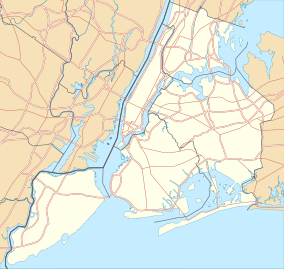
Back جراند ارمى بلازا (ميدان فى امريكا) ARZ Grand Army Plaza (parke sa Tinipong Bansa, Kings County) CEB Grand Army Plaza (Brooklyn) German Grand Army Plaza Spanish Grand Army Plaza (Brooklyn) Estonian Grand Army Plaza (Brooklyn) French גראנד ארמי פלאזה HE 그랜드 아미 플라자 (브루클린) Korean Grand Army Plaza Polish Гранд-Арми-Плаза (Бруклин) Russian
| Grand Army Plaza | |
|---|---|
 Grand Army Plaza viewed from the southeast, anchored by the Soldiers' and Sailors' Arch | |
| Location | Brooklyn, New York City, New York, United States |
| Coordinates | 40°40′27″N 73°58′13″W / 40.6743°N 73.9702°W |
| Area | 14.26 acres (5.77 ha)[1] |
| Elevation | 131 ft (40 m)[2] |
Grand Army Plaza, originally known as Prospect Park Plaza, is a public plaza that comprises the northern corner and the main entrance[3] of Prospect Park in the New York City borough of Brooklyn. It consists of concentric oval rings arranged as streets, with the namesake Plaza Street comprising the outer ring. The inner ring is arranged as an ovoid roadway that carries the main street – Flatbush Avenue. Eight radial roads connect Vanderbilt Avenue; Butler Place; two separate sections of Saint John's Place; Lincoln Place; Eastern Parkway; Prospect Park West; Union Street; and Berkeley Place. The only streets that penetrate to the inner ring are Flatbush Avenue, Vanderbilt Avenue, Prospect Park West, Eastern Parkway, and Union Street.
The plaza includes the Soldiers' and Sailors' Arch; the Bailey Fountain; the John F. Kennedy Monument; statues of Civil War generals Gouverneur K. Warren and Henry Warner Slocum; busts of notable Brooklyn citizens Alexander Skene and Henry W. Maxwell; and two 12-sided gazebos with "granite Tuscan columns, Guastavino vaulting, and bronze finials".[4]: 668
- ^ "Bailey Fountain". Grand Army Plaza. nycgovparks.org. Archived from the original on October 10, 2012. Retrieved August 19, 2011.
- ^ "X_Value=-73.970156&Y_Value=40.674253". USGS Elevation Web Service Query. United States Geological Survey. Archived from the original on March 30, 2012. Retrieved June 24, 2011.
- ^ "Prospect Park". Brooklyn Daily Eagle. June 20, 1867. p. 2. Archived from the original on June 12, 2011. Retrieved February 5, 2019 – via Newspapers.com.
Entering at the main entrance or plaza, the visitor leaves on either side the mounds which flank the spot selected for the Fountain of the Gold Spray.
- ^ White, Norval; Willensky, Elliot (2000). AIA Guide to New York City (4th ed.). New York Chapter, American Institute of Architects; Crown Publishers/Random House. ISBN 0-8129-3106-8.
© MMXXIII Rich X Search. We shall prevail. All rights reserved. Rich X Search


